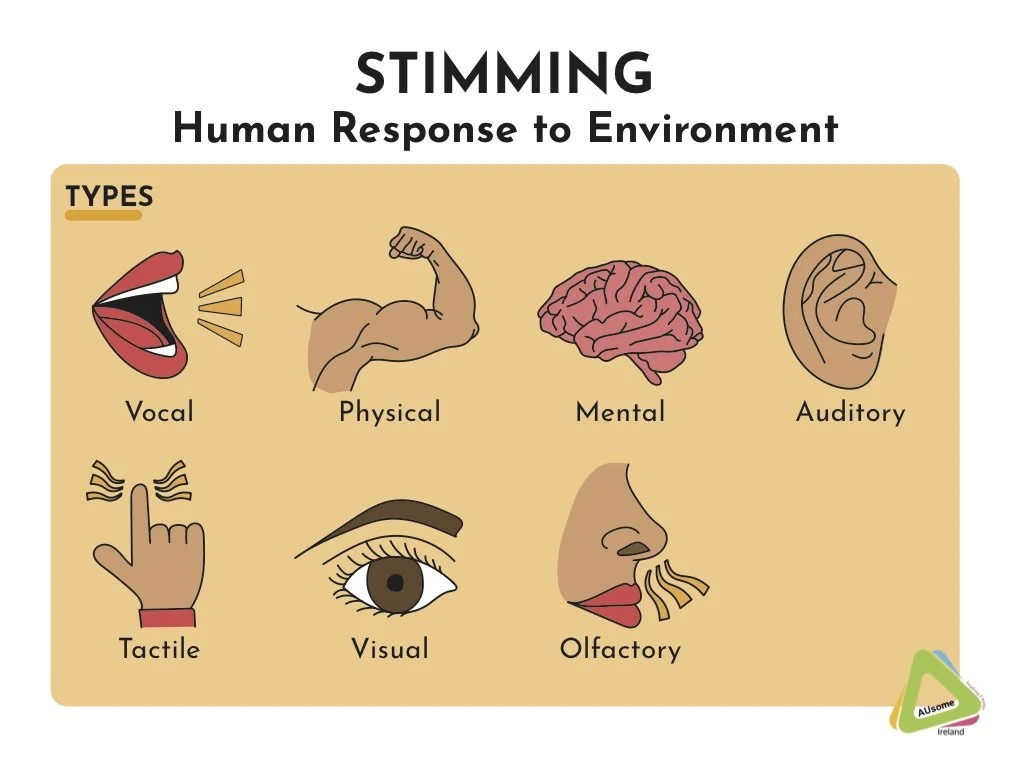Why We Don’t Stop Stimming — And What to Focus on Instead.
“It’s so cute!” my mother-in-law said while spooning pureed carrots into Jake’s mouth. She was referring to his hand flapping joyfully in his high chair.
Jake was born flapping.
It wasn’t something he developed later. It was always there — a natural response when he was excited, engaged, or lit up by the world around him.
I remember Googling “hand flapping” for the first time and reading: “normal until age 3.” I wish I could say I always knew what it meant. But Jake was born on March 3, 2020 — in the earliest days of the pandemic — and for most of his infancy, it was just the three of us. No community, no early intervention, no outside eyes.
At the time, I noticed he wasn’t gesturing much. But he made eye contact. He smiled, laughed, and connected with us. And for a while, that felt like enough.
But as Jake approached 14 months, I started to sense something more.
First, it was the speech delay.
Then, the lack of joint attention and response to name.
And three weeks after his second birthday, we received his autism diagnosis.
What Is Stimming?
Stimming—short for self-stimulatory behavior—refers to repetitive movements, sounds, or actions. Common examples include:
Hand flapping
Rocking
Spinning
Humming
Scripting
Pacing
Tapping
It's important to note that stimming isn't exclusive to autistic individuals. Everyone engages in some form of self-stimulation. You might twirl your hair, tap your foot, or bounce your leg during a meeting. The difference lies in the frequency, intensity, and purpose behind these behaviors.
For autistic individuals, stimming serves several vital functions:
Sensory Regulation: Helps manage sensory input, either by increasing stimulation in under-stimulating environments or decreasing it in overwhelming situations.
Emotional Expression: Acts as a means to express feelings such as excitement, frustration, or anxiety.
Coping Mechanism: Provides comfort and predictability, especially in unfamiliar or stressful situations.
Communication: Serves as a non-verbal way to convey needs or emotions when verbal communication is challenging.
Understanding the multifaceted purposes of stimming is crucial in fostering empathy and support for autistic individuals. For a deeper insight into the significance of stimming, consider reading ‘People should be allowed to do what they like’: Autistic adults’ views and experiences of stimming.
Jake stims in a multitude of ways depending on what he needs. Some like swinging is wonderful for his sensory seeking profile and others like his lip picking isn’t as favored but they all serve a function and it helps us understand him more as he develops language. Jake also being a Gestalt Language Processor likes to listen or watch the same video, song, or script over again. To learn more about GLP check out this blog post: Gestalt Language Processing: How to Know If Your Child is a GLP and What to Do About It.
Why We Don’t Try to Stop It
In our household, stimming is not something we try to eliminate. It's not a behavior to manage or suppress. It's communication.
Now, when Jake flaps his hands, we say:
“You’re so excited!”
We offer him language to connect his physical response to his emotions and experiences.
We don't pathologize it. We partner with it.
Because here's the truth: trying to stop stimming can send the wrong message—that a child's natural instincts are "wrong." That how they move through the world needs to be controlled, masked, or hidden.
And when we do that? We risk becoming the first negative voice they internalize.
For more on embracing neurodiversity and challenging the notion of "fixing" autistic behaviors, read Autism Is Not the Problem—The Need to Fix It Is.
The Risks of Suppressing Stimming
Suppressing stimming behaviors can have unintended negative consequences. Research indicates that discouraging stimming may lead to increased anxiety, emotional dysregulation, and a sense of loss of control.
Moreover, the act of masking or hiding stimming behaviors to conform to societal norms can be mentally exhausting and detrimental to an individual's well-being.
It's essential to recognize that while some stimming behaviors may be socially unconventional, they often serve as vital coping mechanisms for autistic individuals.
To understand the importance of neuroaffirming care, especially after an autism diagnosis, explore Neuroaffirming Care After an Autism Diagnosis: What to Ask, What to Avoid, and Why It Matters.
What to Focus on Instead
Instead of asking “How do I stop this?”
Ask: “What is this behavior telling me?”
Here's where I guide families to focus:
Understanding the Function: Every behavior communicates something. Observing the context and triggers can provide insights into the purpose behind the stimming.
Providing Alternatives: If a particular stimming behavior is harmful or disruptive, offer safer alternatives that fulfill the same sensory or emotional need.
Creating Supportive Environments: Ensure that home, school, and community settings are accommodating and accepting of stimming behaviors.
Educating Others: Advocate for awareness and understanding among educators, peers, and extended family members to foster inclusive environments.
For a comprehensive guide on navigating a new autism diagnosis, check out 10 Things To Do After an Autism Diagnosis.
Final Thoughts
Jake's flapping isn't something we fear—it's something we respect. We understand it. We honor it. And we work with it.
Stimming isn't the problem. Misunderstanding it is.
At Oak & Hive, I help families move from confusion to confidence after a diagnosis. I'm not here to fix your child—I'm here to help you understand them.
Ready to Build a Supportive Therapy Team for Your Child?
Finding the right therapists who understand and support your child's unique needs is crucial. At Oak & Hive Consulting, I specialize in connecting families with neurodiversity-affirming professionals who provide educational tools and strategies tailored to your child's development.
Schedule a Free 25-Minute Consultation
Let's collaborate to create a therapy team that empowers your child and supports your family's journey.
External Resources:





